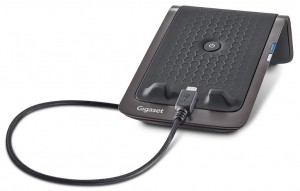Neuheit: Gigaset MobileDock –für Android und iOS
Auf dem Smartphone erreichbar sein und gleichzeitig den Komfort eines Schnurlostelefons nutzen – mit der neuen Gigaset MobileDock LM550 ist das ganz einfach: Sie verbindet das Smartphone via Bluetooth und DECT mit dem Festnetztelefon und leitet eingehende Anrufe direkt an das DECT-Mobilteil weiter. So integriert die innovative MobileDock das Smartphone perfekt in das heimische DECT-Telefonsystem.

Die Gigaset MobileDock LM550 ist das perfekte Gerät, um Android-Smartphones mit dem Festnetztelefon zu Hause zu verbinden. Dank Bluetooth 4.0, Schnellladefunktion und DECT-Verbindung wird das Telefonieren in den eigenen vier Wänden zu einem Erlebnis mit höchstem Komfort. Via Bluetooth und DECT verbindet die MobileDock bis zu zwei Smartphones gleichzeitig mit dem Festnetztelefon. Eingehende Anrufe werden so direkt an alle angemeldeten Mobilteile oder auf das Mobilteil der Wahl weitergeleitet – mit dem vollen Komfort des Festnetztelefons und der DECT-Sprachqualität.
Darüber hinaus dient die LM550 als fester Aufbewahrungsort und Ladestation für das eigene Smartphone. Um eine optisch perfekte Lösung zu bieten, ganz ohne Kabelsalat, ist im Lieferumfang der MobileDock ein kurzes Micro-USB-Kabel enthalten, dessen Stecker magnetisch an der richtigen Position einrastet. Dank der Anrufweiterleitung gehen während der Ladezeit keine Anrufe verloren – der Nutzer bleibt mobil, indem er bequem Anrufe an DECT-Mobilteilen entgegennimmt. Dank der Schnellladefunktion mit bis zu 1500 mA können Nutzer das Haus immer mit vollgeladenem Smartphone-Akku verlassen.

„Mit unserer MobileDock wird das Smartphone unserer Kunden ganz einfach zu einem Teil ihres Festnetzsystems zu Hause“, sagt Dr. Kurt Aretz, Leiter der Business Unit Voice Products. „Die LM550 verknüpft jedes Android-Smartphone mit dem Komfort des DECT-Telefonsystem. Wir sind überzeugt: Nichts ist komfortabler, als eingehende Anrufe mit dem eigenen Festnetztelefon zu beantworten. Mit der Gigaset MobileDock holen wir die mobile Welt in das Zuhause unserer Kunden.“
Die Steuerung der LM550 erfolgt über die MobileDock-App, die im Google PlayStore erhältlich ist. Mithilfe der App kann jeder Nutzer selbst entscheiden, auf welchem der Mobilteile er das Gespräch entgegennehmen möchte. Sobald dieLM550 mit einem Gigaset DECT-Telefon der aktuellen C- und S-Klasse verbunden ist, werden die weitergeleiteten Anrufe auf dem Mobilteil mit Namen oder Nummer angezeigt. Dazu muss die Anruferanzeige am Smartphone aktiviert sein. Bei allen anderen Gigaset-Systemen und DECT-Systemen anderer Herstellern erfolgt die Anrufweiterleitung ohne Namensanzeige als einfacher interner Ruf.
Wer die Rufweiterleitung nicht mehr nutzen möchte, kann sie durch einen Tastendruck direkt an der MobileDockdeaktivieren – das angeschlossene Smartphone wird dabei trotzdem geladen. Zwei Status-LEDs zeigen an, ob die Bluetooth- und DECT-Verbindungen bestehen.
Bei unzureichender GSM-Abdeckung in Gebäuden ist die MobileDock die ideale Lösung. Sie wird an einer Stelle mit gutem Empfang platziert, zum Beispiel an einem Fenster, und leitet von dort aus die eingehenden Anrufe nach DECT-Standard bis zu 50 Meter weit an das Telefonsystem weiter. Der Stromverbrauch der MobileDock ist dank der energiesparenden Steckernetzteile mit weniger als 0,8 Watt äußerst gering. Im Standby-Betrieb ist die MobileDock strahlungsfrei wenn die Basis und alle angemeldeten Mobilteile ECO DECT unterstützen. Die Funkleistung passt sich je nach Entfernung zur Basisstation tomatisch an. Die MobileDock ist kompatibel mit allen Smartphones, die auf Android 4.4 oder höher basieren und über den Funkstandard Bluetooth 4.0 verfügen.
Die Android-Version der Gigaset MobileDock LM550 in Schwarz wird ab Mitte September 2015 zum Preis von 59,99 € (UVP) im Fachhandel sowie im Gigaset Online-Shop erhältlich sein. Ende Oktober folgt die weiße Version LM550i für iOS mit einem USB-Lightning Ladekabel zum Preis von 69,99 € (UVP)



